|
I have always found shooting
conversations using the words long range to be both interesting
and confusing. In
the shooting context, what does long range actually mean?
For one man, this might mean 200 yards; for a shooter
with more skill, this might mean 300 to 400 yards; for a highly
skilled and experienced shooter, this might mean 500 to 600
yards. Obviously,
long range is not solidly defined.
For example, over the last few
years, I have met shooters who reliably and humanely take big
game at ranges approaching 1000 yards and who casually discuss
doing so, as if this were no great thing.
For myself, I would say that targets from 600 to 1000
yards seem to fulfill the definition of long range.
But what about engaging targets at far greater distances?
Here, we enter the realm of ultra-long-range shooting,
where both unique skills and special equipment are required.
Ultra-long-range shooting is
nothing new; this skill has been practiced since the early
1800's and many kills were recorded during the War Between the
States at ranges near one mile, most of those using
muzzle-loading target rifles. Despite that, the rifles perhaps best associated with this
sport are single-shot cartridge guns by Christian Sharps, the
model 1885 Winchester, the Peabody (forerunner of the Martini),
the Trapdoor Springfield, and the Remington Rolling block, but
other types exist. More
recently, we have seen development of newer high-velocity
cartridges that are capable at ranges far beyond 1000 yards,
when chambered in modern, quality rifles.
But where does one go to practice shooting at such
distances?
One place that is unique for
what it offers shooters who are interested in shooting at long
range is the Friends of Billy Dixon Ultra Long Range Shooting
Facility (FoBDSF, or simply, "the range"), located at
the Stengel Gun Shop. This
facility is situated five miles west of Hotchkiss, Colorado,
adjacent to State Highway 92 (on the north side). This range
offers targets and shooting positions for shots to 1800 yards
— by any sporting-arms definition, 40 yards beyond one mile is
long range.
The testing that led to
creation of FoBDSF was originally the brainchild of Bill Falin
and ML (Mic) McPherson.
They enlisted the critical help of Harvey Watt and Paul
Armbruster. Later, McPherson
garnered the support of David Torkelson and Robert “Doc”
Boyle. Without the active participation of all these folks,
likely, this range would never have been developed. However, I
must note that Torkelson was singly responsible for completion
of this dream, and we are all in his debt for this great gift.
McPherson is a well-known author, ballistician, and gunsmith (he
specializes in lever-action Marlin customizing - please visit
his web site: http://www.levergun.com/).
Mic has a serious interest in history. He first learned about
the famous Dixon shot as a child of eight — through a story
told by a distant relative of one who was there. That story
always fascinated McPherson.
Falin headed Handloader
Customer Support at Accurate Arms, and was their Chief
Ballistician. Those positions led him to realize that a
significant need existed for a smokeless propellant that would
duplicate blackpowder loads in original rifles. He was solely
responsible for development and introduction of 5744, as a
standard product in the Accurate Arms line (5744 is now
Accurate’s best-selling propellant) — this smokeless allows
duplication of blackpowder ballistics in any original
blackpowder rifle cartridge.
Watt, a world-class hunter and
marksman, supplied significant financial support and facilitated
the early testing that led to development of the FoBD and
ultimately this range. Armbruster,
a pottery artisan and blacksmith who specializes in Damascus
steel, joined Watt in that early developmental work.
Torkelson is a world-class
shooter, sculptor, and artist. He works in various mediums such
as fossil ivory, nickel iron meteorite, and steel.
Boyle is an Old West historian
and Doc Holliday Portrayalist.
(Being around members of this
iconoclastic group makes for some rather interesting
conversation, to put the matter mildly.)
In the late 1990s, Falin read
about the life of Billy Dixon and how, early in the morning one
June day in 1874, Dixon had ended the second battle of Adobe
Walls by firing a single shot
from a Sharps rifle. The bullet he so carefully launched hit
an Indian warrior who was mounted among a group of approximately
fifteen riders, who were gathered on a distant hillside. Those
warriors were evidently having a powwow about something —
perhaps how best to prepare for the third day of battle; perhaps
how best to withdraw; and, perhaps something else — exactly
what they were discussing we will never know.
Dixon’s bullet hit that
unlucky warrior above the elbow, breaking his arm. The impact so
startled and unsettled him that he fell from his mount. During
the subsequent scramble to reseat their wounded companion, the
Indian leaders immediately assumed a new plan:
This incident obviously indicated bad medicine. They
withdrew without further discussion. Dixon’s amazing
marksmanship so demoralized the Indians that the battle was
unceremoniously abandoned, forthwith.
Several days later, a passing
Army survey crew measured the distance between the spot where
Dixon rested the gun and where blood was found on the ground
(where the warrior had fallen) —1538 yards, just two yards
short of 7/8 mile. By
any standards, that represents a long shot.
For a detailed account of the
historical relevance and authenticity of this event, please read
The
Shot that Changed a War: The Billy Dixon Story, by Steve Lee, located under the articles section of the
Friend's of Billy Dixon website:
http://www.friendsofbillydixon.org/
About 1997, after considerable
discussion, and out of curiosity as to whether the shot could be
duplicated and as a possible plug for 5744 propellant, McPherson
and Falin began efforts to duplicate Dixon's famous long shot.
That June, with the help of McPherson’s
parents (Bob and Joyce), they created a life-size representation
of a rider, found a suitable location (on public land, in the
Grand Valley, northwest of Grand Junction, Colorado) to stand
that target on a barren hillside (where impacts would be apt to
create a visible dust plume) and where they could have a handy
shooting location at the correct distance. Then they began their
quest — to see how feasible Dixon’s shot might have been —
was the hit merely a fluke or did Dixon have reasonable hope of
making such a shot?
Testing that day was with Falin’s 1875 C.
Sharps rifle chambered in 40-60 Falin, using his handloads.
They fired approximately 130 shots and recorded many hits
and dozens of near misses that would certainly have hit a
life-size target representing fifteen riders in a group.
The following year, McPherson
and Falin’s friends, Harvey
Watt (an ex-Cobra helicopter pilot who served in Vietnam) and
Paul Armbruster continued this background work.
They shot in the same area but with a larger target
(approximately 7½x15-feet). This time,
they tested 45- and 50-caliber Sharps rifles. (Unfortunately,
Falin could not be present so further 40-caliber testing did not
occur at that time.)
You can find the full story of these quests, Replicating
Billy Dixon's Legendary Long-Shot, by McPherson,
at the articles page of the FoBD website.
When these men began their efforts, no source
for reliable trajectory data existed for any sort of sporting
bullet fired at such distances.
Therefore, estimating trajectory corrections was a
considerable issue. If you do not have the sights adjusted close
enough to bring bullet impact very close to the target, seeing
the dust marker (impact plume) becomes a matter of pure luck.
These two experiments gave this group enough basic
information for them to know approximately what sight settings
would be needed for any similar gun and load.
At the 1999 Shootists
Holiday, held at the NRA
Whittington Center, McPherson’s
peers asked him to speak about this quest to replicate Billy
Dixon's long shot.
Shortly after this gathering, Torkelson spoke
to McPherson about an
idea that had come to him during that lecture:
What if an organization was founded to create a facility
where Dixon's shot could be attempted by anyone with the
necessary degree of interest, the right tools, and enough
talent?
With blessings, Torkelson discussed his idea
with Boyle (who travels nationally, portraying Doc Holiday, the
infamous gunfighter). Very
shortly thereafter, Boyle, Torkelson, with McPherson
and his wife (Peggy) and daughter (Autumn), Bill Tharp
(Shootist), and others established The Friends of Billy Dixon (FoBD),
which is structured as a non-profit, educational organization,
under the auspices of CCE (Colorado Creative Education). Through
this mechanism, FoBD is chartered as a 501C3, a non-profit
organization.
(Editor’s note: the following three
paragraphs are entirely my creation, partly as an aside, to
explain why the FoBDSF is not located at Whittington Center.)
The Founders of FoBD then developed a
petition, in an effort to encourage Whittington Center to
consider hosting The Friends of Billy Dixon Range, which would
include a shooting line at 1538 yards and targets that we would
provide. Thirty-four shooters signed this petition that day.
In the next two years, with the express
goal of creating a truly long-range facility at Whittington
Center, the Founders gathered about seven thousand dollars in
range-development contributions from shooters and industry
supporters. However, despite three years of intensive effort and
significant expense, FoBD failed to persuade Whittington
management to find a suitable location.
In the face of this disappointment, while
other members of FoBD were unable to continue to contribute
useful assistance, Torkelson single-handedly continued the
search for a suitable location.
That search eventually led to the Stengel Gun Shop and
Shooting Range.
Gerhart (Casey) Stengel’s facility has the
available space to host such a range.
After negotiations that led to a permanent home for the
FoBD range, Torkelson began drawing artistic targets on steel.
Fellow Shootist Alan Aman cut these out of scrap plate steel
that Torkelson had acquired for FoBD.
Aman and Torkelson converted this steel into 27 targets
(10, 1-inch thick, any gun, and 17, 5/16-inch thick
black-powder-class only) — see photographs.
I learned of the FoBD Facility at the 2007
SHOT Show, where McPherson
introduced me to Torkelson and Boyle.
Upon returning home, I soon telephoned my friend, Tym
Hurst, to see if he would want to include a visit to the FoBD
range as part of our annual Spring Break camping trip in 2007.
We then telephoned Torkelson and arranged dates for a
visit.
Unbeknownst to us, we were destined to become
the first members of the general public to shoot at a scheduled
Billy Dixon event at the FoBD range, subsequent to its
inauguration the previous Fall, when only FoBD members
participated.
That Spring, I used my 43 Mauser.
Interested readers can review my earlier experiences with
that 71/84 Mauser, which I named “Old 3120” under “Report
of FoBD Shoot by Andy Tuttle at Leverguns.com” at the previously
mentioned FoBD website.
The evolving shooting range at the Stengel
Gun Shop includes an ever-increasing diverse assortment of
shooting facilities. This
facility is quickly becoming a world-class shooting range.
The majority of the FoBDSF targets are
artistic steel cutouts created by Torkelson and Aman.
Creating these targets required a huge amount of labor.
These include the official Billy Dixon Target (three
riders on horseback), the Billy Breckenridge Target (one rider
on horseback) and bears, elk, mountain lions, buffalo, and
coyotes. Other
targets include circular gongs, calibrated to minutes of angle
at 1000 yards. This facilitates sight adjustments. Thicker steel
diamond targets called the “Dixon Diamonds” tolerate any
sporting rifle bullet.
McPherson cleverly designed a minute-of-angle (MOA) grid behind the
Billy Dixon Target. This allows the spotter (located near the
impact zone in a protective observation booth) to report to a
spotter at the firing line, by radio, precise MOA sight
adjustment corrections, as needed to get the shooter on target.
The various shooting lines allow a shooter to learn the
trajectory of a rifle and load at various incremental distances,
from 100 yards, to beyond one mile.
My experience has been that one’s knowledge
and shooting skills improve significantly after one supervised
visit to this range. The historical education, educational
shooting opportunities, and coaching provided are just that
good.
FoBD leadership continues to develop
competitive games. These include the Billy Dixon: Five Shot,
Billy Breckenridge Shot, and Dixon Diamond: One Shot.
Those participating in the Billy Dixon: Five
Shot event are given sight-in time on the Billy Dixon target,
shooting from the official (1538-yard) shooting line. After all shooters have a basic zero, all are allowed five
shots at the Billy Dixon target, for score.
Each shooter’s first shot gives that person
a chance to duplicate Dixon's famous shot. A hit on that shot
will earn that shooter the official Billy Dixon Medallion. After all shooters have had one shot, each is given four more
shots, for score — whoever makes the most hits, wins. If a
tie, the event goes to a shoot off. If no one hits the target,
no one wins. (Boyle won the inaugural event.)
A feature of this event is that, in an effort
to maintain historical perspective, any hit on steel counts.
This is because it would not have mattered how Dixon had
drawn blood and it would not have mattered if that blood was
human or equine. Almost certainly, the warriors would have
considered any hit, to horse or to rider, direct or ricochet, as
equally Bad Medicine.
The Billy Breckenridge Shot allows similar
preparation before taking one shot at the Breckenridge Target,
which represents a face-on mounted rider at 880 yards.
This event thus duplicates Breckenridge's historical
feat.
The Dixon Diamond One Shot is a game played
with targets at ranges from 200-1538 yards (or beyond).
This includes five shots for score. One shot at one
target at each of five mutually agreed upon distances. This game
includes sighting in on one of the five targets (of the
shooter’s choice). Shoot offs usually involve choosing smaller
diamonds or those at greater distance. This game allows the
participants to match the difficulty to their skills and
equipment.
A unique characteristic of the FoBD
organization and facility is the level of camaraderie among
those who run the facility and among participants in both formal
and informal events. FoBD’s
goal is not just to provide a place for competition but, more
importantly, to provide a low-pressure shooting environment
where everyone can enjoy themselves and learn and practice new
skills with help from possibly more experienced shooters.
In the modern competitive shooting world, where
sportsmanship and good will sometimes take a back seat to the
intense pressure of competition, the FoBDSF is a welcome
retreat.
As noted, the FoBD is affiliated with a
non-profit, educational organization (CCE — Colorado Creative
Education). Education
is part of every FoBD event. The historical significance of the
incident that the participants will in some small measure
re-enact is always emphasized. The importance of the firearms
and technologies in use at the time of the original incident is
also discussed, as well as the fact that extreme long-range
precision shooting has not progressed much since that time (as a
matter of fact, most modern rifles and loads cannot be used
effectively for shots at the longest distances available at this
range). All
sanctioned FoBD events include an educational lecture.
FoBD founding members agree that failing to
learn from history destines us to repeat the same mistakes. They
also have a keen awareness of how the lives and actions of those
that have gone before have influenced our modern world. A review
of the associated articles should clarify just how seriously
these folks take the study of history.
As previously noted, the range at Stengel Gun
Shop offers diverse shooting opportunities, in addition to FoBD
targets and shooting lines.
Included is a National Rifle Association approved High
Power Rifle target array. This includes twelve shooting
positions and twelve target standards (see pictures). For
Highpower Competition, these targets are officially used at
200-, 300-, 600- and 1000-yard distances.
Interestingly, this facility also offers one
the ability to shoot bench rest at these paper targets at 1328
yards. As far as I know, this is a unique opportunity in the US.
Torkelson currently holds the 22-caliber range record, a
five-shot group just under 20.4 inches.
He used a custom rifle chambered for the 22x45 SMc
(a cartridge developed by Superior Ballistics co-founders, McPherson
and Smalley):
http://www.superiorballistics.com
The range at Stengel Gun Shop also offers
Trap, Skeet, Bench Rest (to 300 yards), steel gong targets at
various distances out to 700 yards (independent from FoBDSF
targets), National Rifle Association Falling Plates and
Silhouette, Cowboy Action bays (with monthly SASS meetings),
Small Bore Youth Programs, Small Bore Silhouette, Action Pistol
(with events), and an National Rifle Association PPC course with
national Competitions.
I coordinated a Journalist Invitational in
April 2009. In that
event, a small group of friends and local shooters enjoyed what
the FoBDSF had to offer. Attendees
included: Tym Hurst, Mic McPherson
(Shootist), Butch and Shirley Jarvis (devoted shooting
enthusiasts), Jim Williamson (Shootist), Bill Tharp (Shootist),
Randy Arnt, By Smalley (Superior Ballistics), Alan Aman
(Shootist), David Torkelson (Shootist), and me.
Prior to the arrival of other shooters,
Hurst, Torkelson, and I enjoyed shooting off-hand at shorter
distances with iron-sighted lever guns (200-300 yards).
In an unofficial game of “Dixon Diamond One Shot”
between Torkelson and me, I managed one more hit than he did.
(Yes, I am bragging, beating Torkelson at any shooting
game is no mean feat!)
The following day, when all participants had
arrived, we held the main event — The Billy Dixon: Five-Shot.
Rifles used included 71/84 Mausers, modern 1895
Winchesters, modern 1874 Sharps, Peabody, and Trapdoor
Springfield. Shooters used heavy lead bullets and black-powder
or equivalent smokeless-powder loads.
No one managed to hit the Billy Dixon Target
on their first shot-for-record attempt. As shooting progressed, a tie developed between Shirley
Jarvis of “Team Jarvis” and Alan Aman.
A “sudden death” shoot-off determined the winner.
McPherson and I
were down range in the observation booth. We spotted and
listened as Jarvis and Aman alternated shots, in order.
Hearing the shots and the bullets go by was
extremely exciting. First, the very faint but obvious report of
the shot; then, the sound of the bullet as it passed by, only a
few dozen yards from our safe location — the fudda, fudda,
fudda sound is quite unique; then, to hear the impact in the
dirt, as the bullet narrowly missed hitting steel. Finally, on
his third shot, Aman’s bullet found steel. From our location,
the loud clang was obvious. Aman was the winner.
Afterwards (after setting the appropriate
safety flags), all participants loaded into vehicles and came
down range to observe the target.
Various folks took photographs.
This solidified the memory of the event for everyone
involved.
Casey Stengel has created a wonderful place
to shoot. Amicable people run this range. It provides a unique
opportunity to practice one’s long-range marksmanship, make
new friends, and learn about remarkable historical events.
We are already planning the 2010 event
schedule. That
information and more details on this range and The Friends of
Billy Dixon is available at the website:
http://www.friendsofbillydixon.org/
Hope to see you there in 2010.
FoBD
and others who are interested in long-range shooting owe a debt
to Boyle and his wife, Caroline.
They created and are maintaining the user-friendly and
informative FoBD web site.
This represents considerable effort.
Without this contribution, FoBD would have almost no
presence on the World Wide Web. Caroline is http://www.coyotecreative.net/
Andy
Tuttle
  
Got something to say about this article?
Want to agree (or disagree) with it? Click the following link to
go to the GUNBlast Feedback Page.
|
|
Click pictures for a larger version.
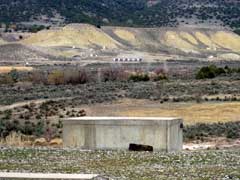
All FOBDSR targets, as seen from the 1538-yard firing
line.
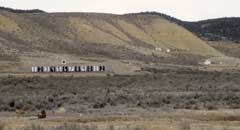
NRA High-Power (left), Billy Dixon and High-Power
Diamond targets (right).
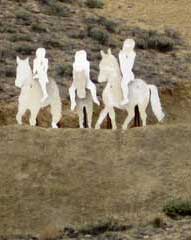
Billy Dixon target, as seen from near the observation
booth.
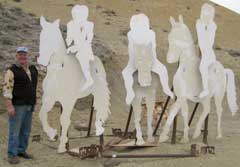
Torkelson created the FOBD target.
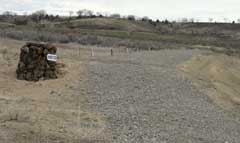
200-yard NRA shooting line.
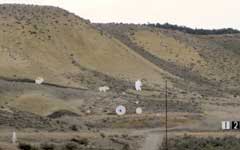
Breckenridge target (left), calibrated gongs
(center), NRA High-Power (right).
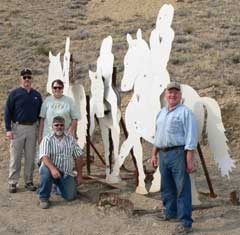
L-R: Bill, Deb, Mic and Dave at the Billy Dixon
target 2008.
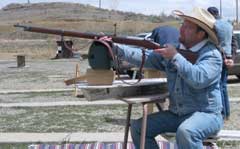
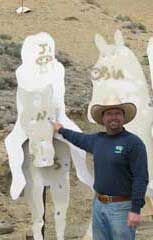
Author Tuttle with 71-84 43 Mauser.
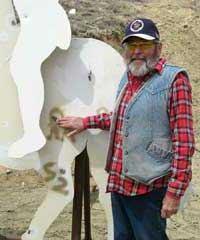
Aman, co-builder of FOBD targets, indicates one of
his hits.
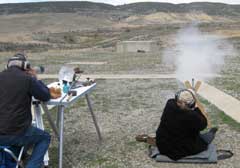
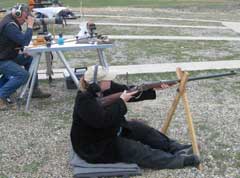
Shirley Jarvis shoots while Butch Jarvis spots.
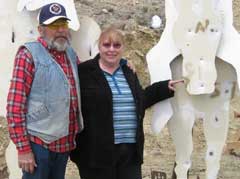
Aman (winner) and Jarvis (runner-up) at the 2009
Journalist Invitational.
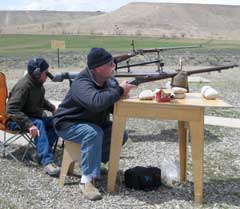
Williamson shoots Trapdoor, Tharp spots.
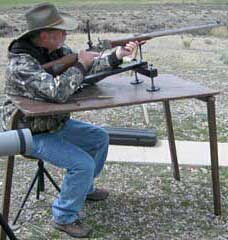
Arnt with his Sharps rifle - notice sight staff.
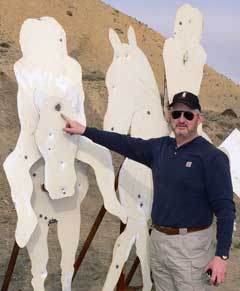
Bill showing hit on the Billy Dixon target 2008.
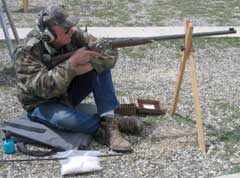
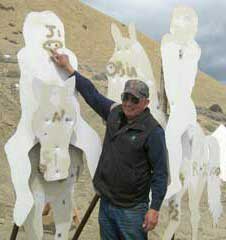
Butch Jarvis.
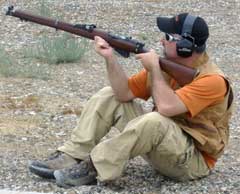
Hurst firing 303 Enfield at 1538 yards.
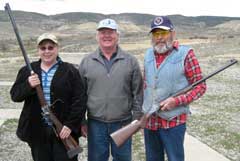
L-R: Jarvis, Torkelson, Aman.
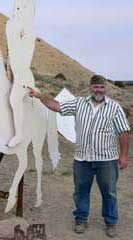
McPherson showing hit on the Billy Dixon target 2008.
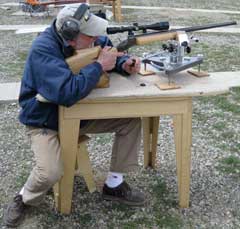
By Smalley with 45-70 Rolling Block, "Old Nose
Buster".
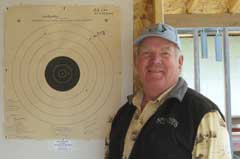
Torkelson with range record target - 22x45 SMc at
1328 yards.
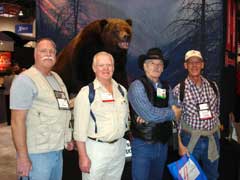
Williamson, Torkelson, Boyle, Tharp at SHOT
2008.
|
![]()